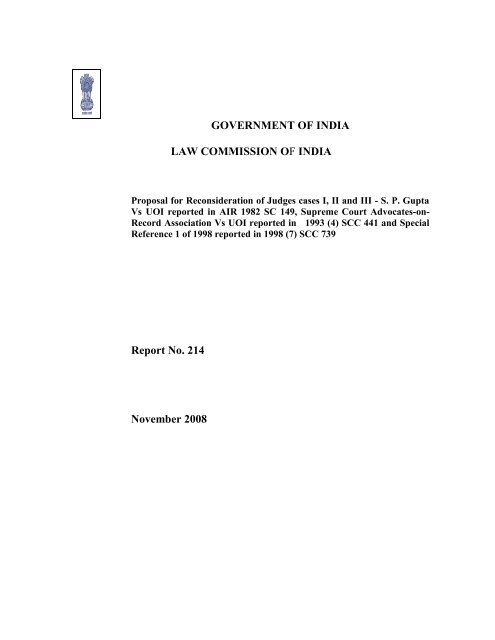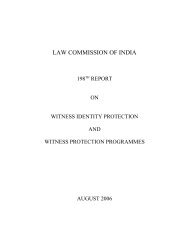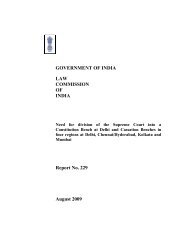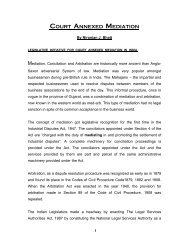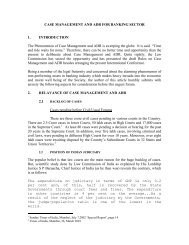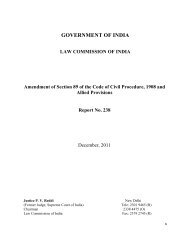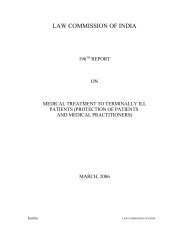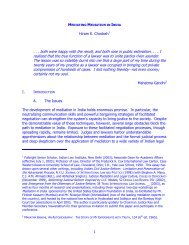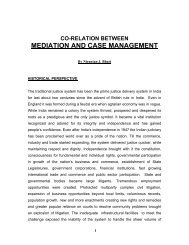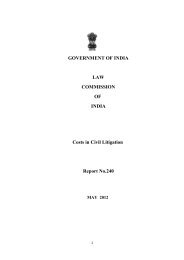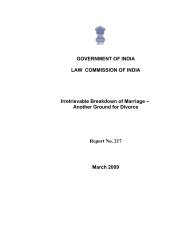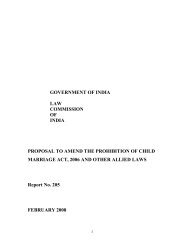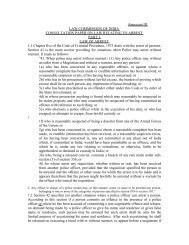214th Report - Law Commission of India
214th Report - Law Commission of India
214th Report - Law Commission of India
Create successful ePaper yourself
Turn your PDF publications into a flip-book with our unique Google optimized e-Paper software.
GOVERNMENT OF INDIALAW COMMISSION OF INDIAProposal for Reconsideration <strong>of</strong> Judges cases I, II and III - S. P. GuptaVs UOI reported in AIR 1982 SC 149, Supreme Court Advocates-on-Record Association Vs UOI reported in 1993 (4) SCC 441 and SpecialReference 1 <strong>of</strong> 1998 reported in 1998 (7) SCC 739<strong>Report</strong> No. 214November 2008
2THE LAW COMMISSION OF INDIA(REPORT NO. 214)Proposal for Reconsideration <strong>of</strong> Judges cases I, II and III - S. P. Gupta Vs UOIreported in AIR 1982 SC 149, Supreme Court Advocates-on-RecordAssociation Vs UOI reported in 1993 (4) SCC 441 and Special Reference 1 <strong>of</strong>1998 reported in 1998 (7) SCC 739Forwarded to the Union Minister for <strong>Law</strong> and Justice, Ministry <strong>of</strong> <strong>Law</strong> andJustice, Government <strong>of</strong> <strong>India</strong> by Dr. Justice AR. Lakshmanan, Chairman, <strong>Law</strong><strong>Commission</strong> <strong>of</strong> <strong>India</strong>, on 21st day <strong>of</strong> November, 2008.
3The 18 th <strong>Law</strong> <strong>Commission</strong> was constituted for a period <strong>of</strong> threeyears from 1 st September, 2006 by Order No. A.45012/1/2006-Admn.III (LA) dated the 16 th October, 2006, issued by theGovernment <strong>of</strong> <strong>India</strong>, Ministry <strong>of</strong> <strong>Law</strong> and Justice, Department <strong>of</strong>Legal Affairs, New Delhi.The <strong>Law</strong> <strong>Commission</strong> consists <strong>of</strong> the Chairman, the Member-Secretary, one full-time Member and seven part-time Members.ChairmanHon’ble Dr. Justice AR. LakshmananMember-SecretaryDr. Brahm A. AgrawalFull-time MemberPr<strong>of</strong>. Dr. Tahir MahmoodPart-time MembersDr. (Mrs.) Devinder Kumari RahejaDr. K. N. Chandrasekharan PillaiPr<strong>of</strong>. (Mrs.) Lakshmi JambholkarSmt. Kirti SinghShri Justice I. VenkatanarayanaShri O.P. SharmaDr. (Mrs.) Shyamlha Pappu
4The <strong>Law</strong> <strong>Commission</strong> is located in ILI Building,2 nd Floor, Bhagwan Das Road,New Delhi-110 001<strong>Law</strong> <strong>Commission</strong> StaffMember-SecretaryDr. Brahm A. AgrawalResearch StaffShri Sushil KumarMs. Pawan SharmaShri J. T. Sulaxan RaoShri A. K. UpadhyayDr. V. K. Singh:JointSecretary& <strong>Law</strong> Officer: Additional <strong>Law</strong> Officer: Additional <strong>Law</strong> Officer: Deputy <strong>Law</strong> Officer: Assistant Legal AdviserAdministrative StaffShri Sushil KumarShri D. ChoudhuryShri S. K. BasuSmt. Rajni Sharma:JointSecretary& <strong>Law</strong> Officer: Under Secretary: Section Officer: Assistant Library &Information Officer
5The text <strong>of</strong> this <strong>Report</strong> is available on the Internet at:http://www.lawcommission<strong>of</strong>india.nic.in© Government Copyright 2008<strong>Law</strong> <strong>Commission</strong> <strong>of</strong> <strong>India</strong>Government <strong>of</strong> <strong>India</strong>Ministry <strong>of</strong> <strong>Law</strong> and JusticeDepartment <strong>of</strong> Legal AffairsNew Delhi-110001<strong>India</strong>The text in this document (excluding the Government Logos) maybe reproduced free <strong>of</strong> charge in any format or medium providedthat it is reproduced accurately and not used in a misleadingcontext. The material must be acknowledged as Governmentcopyright and the title <strong>of</strong> the document specified.Any enquiries relating to this <strong>Report</strong> should be addressed to theMember- Secretary, the <strong>Law</strong> <strong>Commission</strong> <strong>of</strong> <strong>India</strong>, 2 nd Floor, ILIBuilding, Bhagwandas Road, New Delhi-110001, <strong>India</strong>. Fax:91-11-23388870 or E-Mail to lci-dla@nic.in
6Dr. Justice AR. Lakshmanan ILI Building (IInd Floor),(Former Judge, Supreme Court <strong>of</strong> <strong>India</strong>) Bhagwandas Road,Chairman, <strong>Law</strong> <strong>Commission</strong> <strong>of</strong> <strong>India</strong> New Delhi-110 001Tel.: 91-11-23384475Fax: 91-23383564Respected Shri Bhardwajji,21.11.208I am herewith enclosing our 214 th <strong>Report</strong> on “Proposal for Reconsideration <strong>of</strong>Judges cases I, I and III – S.P. Gupta Vs UOI reported in AIR 1982 SC 149,Supreme Court Advocates on Record Association Vs UOI reported in 1993(4) SCC 441 and Special Reference 1 <strong>of</strong> 1998 reported in 1998 (7) SC 739”.The proposal was placed before the Members <strong>of</strong> the <strong>Commission</strong> at 3.30 p.m.today. The Members <strong>of</strong> the <strong>Commission</strong> after due discussion anddeliberations have unanimously approved the report <strong>of</strong> the <strong>Commission</strong>. The<strong>Commission</strong>, as already stated, examined the law on the subject. Variousrecommendations <strong>of</strong> Parliamentary Standing Committees and law <strong>of</strong> foreignjurisdiction like America, Australia, Canada and Kenya, where the executiveis the sole authority to appoint Judges or the executive appoints inconsultation with the Chief Justice <strong>of</strong> the Country have also been considered.I request you to consider this report and do the needful at the earliest.Since the matter is <strong>of</strong> great importance, I am submitting this reporttoday itself.Yours sincerely,Shri H.R. Bhardwaj,Hon’ble Minister for <strong>Law</strong> & Justice,( AR. Lakshmanan )------------------------------------------------------------------------------------------------------------Residence: No.1,Janpath, New Delhi-110011. Tel.:91-11-23019465.23793488.23792745E-mail:ch.lc@sb.nic.in
7PROPOSAL FOR RECONSIDERATION OF JUDGES CASES I, II &III – S.P..Gupta Vs UOI reported in AIR 1982 SupremeCourt Advocates on Record Association Vs UOIreported in 1993(4) SCC 441 and Special Reference 1<strong>of</strong> 1998 reported in 1998 (7) SCC 739Preface : Part 11) Why reconsideration? The Supreme Court inSubhash Sharma Vs U.O.I. (reported in 1991(1)Supp. SCC 594) presided over by Ranganath MisraCJ, M.N. Venkatachaliah and M.M. Punchi JJ hadexpressed, doubts about the correctness <strong>of</strong> theinterpretation <strong>of</strong> the word “consultation” inregard to the appointment <strong>of</strong> judges in S.P.Gupta Vs U.O.I. (reported in 1982 SC 149) in thefollowing words (in paras 43 & 45 <strong>of</strong> the saidjudgment):-“The word ‘consultation’ is used in aconstitutional provision in recognition <strong>of</strong> thestatus <strong>of</strong> the High constitutional dignitary who
8formally expresses the result <strong>of</strong> theinstitutional process leading to the appointment<strong>of</strong> judges.To limit that expression to itsliteral limitation shorn <strong>of</strong> its constitutionalbackground and purpose is to borrow JusticeFrankfurter’s phrase “to stick in the bark <strong>of</strong>words.”The judges in that case had opined that“Judicial Review is a part <strong>of</strong> the basicconstitutional structure and one <strong>of</strong> the basicfeatures <strong>of</strong> the essential <strong>India</strong>n constitutionalpolicy.The essential constitutional doctrinedoes not by itself justify or necessitate anyprimacy <strong>of</strong> the executive wing on the ground <strong>of</strong>its political accountability to the electorate.On the contrary what is necessary is aninterpretation sustaining the strength andvitality <strong>of</strong> Judicial Review.It might undercertain circumstances be said that government isnot bound to appoint a Judge so recommended by
9the judicial wing.But to contemplate a powerfor the executive to appoint a person despitehis being disapproved or not recommended by theChief Justice <strong>of</strong> the State and the Chief Justice<strong>of</strong> <strong>India</strong> would be wholly inappropriate and wouldconstitute an arbitrary exercise <strong>of</strong> power. Thenagain, whenever there might be difference <strong>of</strong>opinion between the Chief Justice <strong>of</strong> a state andthe Chief Justice <strong>of</strong> <strong>India</strong> – Some <strong>of</strong> the weightyreasons in this behalf are set out by the otherthree Judges in their opinion – the opinion <strong>of</strong>the Chief Justice <strong>of</strong> <strong>India</strong> should have thepreponderant role. We are <strong>of</strong> the view that theprimacy <strong>of</strong> the Chief Justice <strong>of</strong> <strong>India</strong> in theprocess <strong>of</strong> selection would improve the quality<strong>of</strong> selection. The purpose <strong>of</strong> the ‘consultation’is to safeguard the independence <strong>of</strong> thejudiciary and to ensure selection <strong>of</strong> properpersons.The matter is not, therefore, to beconsidered that the final say is the exclusive
10prerogative <strong>of</strong> the executive government.Therecommendations <strong>of</strong> the appropriateconstitutional functionaries from the judicialorgan <strong>of</strong> the State has an equally importantrole.“Consultation should have sinews toachieve the constitutional purpose and shouldnot be rendered sterile by a literalinterpretation.Who is able to decide thequalities <strong>of</strong> lawyers proposed to be elevated tothe bench more than the judges <strong>of</strong> the SuperiorCourts before whom they practice?There arepreponderant and compelling considerations whythe views <strong>of</strong> the Chief Justices <strong>of</strong> the Statesand that <strong>of</strong> the Chief Justice <strong>of</strong> <strong>India</strong> should beafforded a decisive import unless the executivehas some material in its possession which mayindicate that the appointment is otherwiseundesirable.(Para 44)The View which the four learned judges shared inGupta’s case, in our opinion, does not recognize
11the special and pivotal position <strong>of</strong> theinstitution <strong>of</strong> the Chief Justice <strong>of</strong> <strong>India</strong>.(Para45) The correctness <strong>of</strong> the opinion <strong>of</strong> themajority in S.P. Gupta case relating to thestatus and importance <strong>of</strong> consultation, theprimacy <strong>of</strong> the position <strong>of</strong> the Chief Justice <strong>of</strong><strong>India</strong> and the view that the fixation <strong>of</strong> Judgestrength is not justiciable should bereconsidered by a larger bench. (Para 45)Emphasis SuppliedThe operative part <strong>of</strong> the order <strong>of</strong> reference iscontained in para 49 “as in our opinion thecorrectness <strong>of</strong> the majority view in S.P. Guptacase should be considered by a larger bench wedirect the papers <strong>of</strong> W.P. No. 1303 <strong>of</strong> 1987 to beplaced before the learned Chief Justice forconstituting a bench <strong>of</strong> nine Judges to examinethe two questions we have referred to above,namely, the position <strong>of</strong> the Chief Justice <strong>of</strong><strong>India</strong> with reference to primacy and, secondly,
12justiciability <strong>of</strong> fixation <strong>of</strong> judge strength”.In para 51 the Hon’ble Bench has clarified:-We clarify that apart from the two questionswhich we have indicated, all other aspects dealtwith by us are intended to be final by ourpresent order. (Emphasis supplied)Therefore, only two questions were referred tothe bench <strong>of</strong> nine judges namely (1) The position<strong>of</strong> the Chief Justice <strong>of</strong> <strong>India</strong> with reference toprimacy and (2) The justiciability <strong>of</strong> thefixation <strong>of</strong> the judge strength. It is importantto note that no other question was referred tothe larger bench.2. The first judges case S.P. Gupta Vs Union <strong>of</strong><strong>India</strong> and Ors.At this point it may berelevant to know as to what was decided by themajority judgment in the bench presided overby P.N. Bhagwati, A.C. Gupta, S.M. Fazal Ali,V.D. Tulzapurkar, D.A. Desai, R.S. Pathak and
13E.S. Venkataramaiah JJ, in S.P. Gupta’s casethe correctness <strong>of</strong> which was doubted inSubhash Sharma’s case.The relevant portion <strong>of</strong> the majority judgmentdelivered by Justice P.N.Bhagwati speaking forhimself in regard to the expression“consultation” occurring in 217 <strong>of</strong> theconstitution is extracted herebelow:“Each <strong>of</strong> the three constitutionalfunctionaries occupies a high constitutional<strong>of</strong>fice and Cl. (1) <strong>of</strong> Art. 217 provides thatthe appointment <strong>of</strong> a High Court Judge shall bemade after consultation with the functionarieswithout assigning superiority to the opinion<strong>of</strong> one over that <strong>of</strong> another. It is true thatthe Chief Justice <strong>of</strong> <strong>India</strong> is the head <strong>of</strong> the<strong>India</strong>n judiciary and may be figurativelydescribed as paterfamilias <strong>of</strong> the brotherhood<strong>of</strong> Judges but the Chief Justice <strong>of</strong> a HighCourt is also an equally important
14constitutional functionary and it is notpossible to say that so far as theconsultative process is concerned, he is inany way less important than the Chief Justice<strong>of</strong> <strong>India</strong>.In fact, under the constitutionalscheme, the Chief Justice <strong>of</strong> a High Court isnot subject to the administrativesuperintendence <strong>of</strong> the Chief Justice <strong>of</strong> <strong>India</strong>nor is under the control <strong>of</strong> supervision <strong>of</strong> theChief Justice <strong>of</strong> <strong>India</strong>………..If primacy were to be given to the opinion <strong>of</strong>the Chief Justice <strong>of</strong> <strong>India</strong>, it would, ineffect and substance amount to concurrence,because giving primacy would mean that hisopinion must prevail over that <strong>of</strong> the ChiefJustice <strong>of</strong> the High Court and the Governor <strong>of</strong>the State, which means that the CentralGovernment must accept his opinion. But it isonly consultation and not concurrence <strong>of</strong> the
15Chief Justice <strong>of</strong> <strong>India</strong> that is provided in Cl.(1) <strong>of</strong> Art. 217.(Para 29). (emphasis supplied)There must be a collegium to makerecommendation to the President in regard toappointment <strong>of</strong> a Supreme Court or High CourtJudge.The recommending authority should bein consultation with wider interests. If thecollegium is composed <strong>of</strong> persons who areexpected to have knowledge <strong>of</strong> the persons whomay be fit for appointment on the Bench and <strong>of</strong>qualities required for appointment and thislast requirement is absolutely essential – itwould go a long way towards securing the rightkind <strong>of</strong> Judges, who would be truly independentand who would invest the judicial process withsignificance and meaning for the deprived andexploited sections <strong>of</strong> humanity.” (para 30)Regarding fixation <strong>of</strong> judge strength themajority judgment was <strong>of</strong> the view that thiswas not justiciable and no Mandamus could
16issue. This aspect however has lost itssignificance because in the case <strong>of</strong> SubhashGupta the Attorney General made a statementthat the government had no objection to theHon’ble Court going into the question.3. The second Judges case Supreme Court Advocateson Record Association and others vs U.O.I.(reported in 1993(4) SCC 441It is in this backdrop that the nine judgesbench was constituted and judgment wasdelivered on 06/10/1993. The judgment runsinto 306 pages and travels far beyond theorder <strong>of</strong> reference.Noted jurist Late H.M.Seervai in his Constitutional <strong>Law</strong> <strong>of</strong> <strong>India</strong>fourth edition Silver Jubilee Edition (Volume1) has criticized this judgment and called it“null and void” for not following themandatory provisions <strong>of</strong> article 145(4) and (5)– (which is clear from the dissenting judgment<strong>of</strong> Justice M.M. Punchi, the relevant portion
17<strong>of</strong> which is reproduced in the succeeding para)– which are not a matter <strong>of</strong> form ortechnicality but a matter <strong>of</strong> substance aspointed out in Mohhammad Akill vs Azad-unnisaaBibi’s case by Sir Barrnes Peacock C.J.,speaking on this point for a bench <strong>of</strong> ninejudges. “It is not a mere technical objectionbut is upon a fundamental principle essentialto the due administration <strong>of</strong> justice thatevery judicial act which is done by theseveral judges ought to be completed in thepresence <strong>of</strong> the whole <strong>of</strong> them…If afterdiscussion, and after deliberately weighingthe arguments <strong>of</strong> each other, the judges cannotagree, their several judgments ought to bedelivered in open court in the presence <strong>of</strong> theothers.” (Wyman’s <strong>Report</strong> Vol.5, p.69 quoted inRohilkhand Kumaon Bank Ltd. vs Row (1884) 6All. 468 at 474. (taken from Seervai’sConstitutional <strong>Law</strong> <strong>of</strong> <strong>India</strong> fourth edition
18vol.3).The noted jurist calls the judgment “null andvoid” (please see page 2936 Constitutional <strong>Law</strong><strong>of</strong> <strong>India</strong> by H M Seervai volume 3 fourthedition)At this stage it is essential to note thelament contained in the opening paragraph <strong>of</strong>Justice M M Punchi’s dissenting judgment atpara 488 <strong>of</strong> 1993 (4) SCC 441 referred to inthe preceding paras.“Para 488 – M.M. Punchi J. (dissenting) – Thisopinion is in the nature <strong>of</strong> epilogue, thoughnot in stricto sensu.Much has already beenwritten on the two topics under reference tothis Bench, and on others as well withoutreference.I on my part would have liked toavoid making any addition thereto but it seemsthe turn <strong>of</strong> events leave me no choice. I feelit would be dereliction to withhold
19contributing and leave unsaid what needs to besaid (emphasis supplied)Para 490 – “This nine judge bench sat fromApril 7, 1993, to hear this momentous matterconcluding its hearing on May 11, 1993 closeto the onset <strong>of</strong> the summer vacation.Ientertained the belief that we all, after July12, 1993, on the reopening <strong>of</strong> the Court, ifnot earlier, would sit together and hold somemeaningful meetings, having a free and frankdiscussion on each and every topic which hadengaged our attention, striving for aunanimous decision in this historic matterconcerning mainly the institution <strong>of</strong> the ChiefJustice <strong>of</strong> <strong>India</strong>, relatable to this Court. Iwas indeed overtaken when I received the draftopinion dated June 14, 1993 authored by mylearned brother J.S. Verma, J. for himself andon behalf <strong>of</strong> my learned Brethren YogeshwarDayal, G.N. Ray, Dr. A.S. Anand and S.P.
20Bharucha, JJ.The fait accompli appeared astark reality; the majority opinion anaccomplishment. The hopes I entertained <strong>of</strong> afree and frank discussion vanished. But thencame the opinion dated August 24, 1993 <strong>of</strong> mylearned brother Ahmadi, J. like a pebble <strong>of</strong>hope hewn out <strong>of</strong> a mountain <strong>of</strong> despair,followed by the opinions <strong>of</strong> my learnedBrethern Kuldip Singh and Pandian, JJ. datedSeptember 7, 1993 and September 9, 1993respectively. No meaningful meeting thereafterwas possible as the views by that time seemedto have been polarized. So now the firmopinions <strong>of</strong> the eight Brethren, ascommunicated, are known to me.Loaded withthese opinions, I set out to express my own,more as a duty to the venture embarked upon,for I owe it immeasurably, for being party tothe referral.”
21Para 491 – “At the outset, I must remove amisgiving pertaining to the contents andthrust <strong>of</strong> the order <strong>of</strong> referral re correctness<strong>of</strong> S.P. Gupta vs Union <strong>of</strong> <strong>India</strong>, the opinion<strong>of</strong> which was authored by the then ChiefJustice <strong>of</strong> <strong>India</strong>, Shri Ranganath Misra, andconcurred to by the present Chief Justice <strong>of</strong><strong>India</strong> Shri M.N. Venkatachaliah (then as apuisne judge) and by me. We had referred onlytwo questions to a Bench <strong>of</strong> nine Judges,namely, to test the correctness <strong>of</strong> the opinion<strong>of</strong> the majority in S.P. Gupta case relating tothe status and importance <strong>of</strong> consultation andthe primacy <strong>of</strong> the position <strong>of</strong> the ChiefJustice <strong>of</strong> <strong>India</strong>, and whether fixation <strong>of</strong>Judge strength was not justiciable, clarifyingin the ultimate paragraph that apart from thetwo questions aforeindicated all other aspectsdealt with were intended to be final by thesaid order. As I view it, due to the rigidity
22<strong>of</strong> its terms, except for the two questionsspecifically referred, no other matter wasopen to canvass as has seemingly been done.(full text is not extracted for the sake <strong>of</strong>brevity. “Please see page 712 <strong>of</strong> thejudgment).In the penultimate para <strong>of</strong> his concurringjudgment Kuldip Singh J. whose judgment cameas late as September 7, 1993 (when theoriginal majority judgment was signed on 14 thJune, 1995) makes the following observations“Before parting with the judgment it would beappropriate to say that the opinion circulatedby Verma J. was based on elaborate discussionamongst the Brother Judges who were availableand participated in the discussion.AlthoughVerma, J. incorporated various suggestions inhis original draft but a feeling left lurkingin my mind that I have something more to say
23in support <strong>of</strong> the conclusions reached byVerma, J. and that is how I ventured to embarkupon writing a separate opinion”.It is therefore clear that there was nodiscussion, no meeting <strong>of</strong> minds and noconsensus among the 9 judges on 14 <strong>of</strong> June1993 when the final draft judgment was signedby Justice Verma who spoke for himself and onbehalf <strong>of</strong> Yogeshwar Dayal, G.N. Ray, Dr. A.S.Anand and S.P. Bharucha, JJ.The judgmenttherefore plainly is Per Incuriam.4. What was decided by the majority judgmentheaded by Justice Verma?Following the suggestion made by JusticeBhagwati in the SP Gupta case that thereshould be a ‘collegium’ which should beconsulted by the Chief Justice <strong>of</strong> <strong>India</strong> inevery appointment the nine judge bench,speaking through Justice Verma laid downfourteen conclusions which are as follows:-
241.The process <strong>of</strong> appointment <strong>of</strong> Judges to theSupreme Court and the High Courts is anintegrated ‘participatory consultativeprocess’ for selecting the best and mostsuitable persons available for appointment;and all the constitutional functionariesmust perform this duty collectively with aview primarily to reach an agreed decision,sub serving the constitutional purpose, sothat the occasion <strong>of</strong> primacy does notarise.2.Initiation <strong>of</strong> the proposal for appointmentin the case <strong>of</strong> the Supreme Court must be bythe Chief Justice <strong>of</strong> <strong>India</strong>, and in the case<strong>of</strong> a High Court by the Chief Justice <strong>of</strong> thatHigh Court; and for transfer <strong>of</strong> aJudge/Chief Justice <strong>of</strong> a High Court, theproposal has to be initiated by the ChiefJustice <strong>of</strong> <strong>India</strong>.This is the manner inwhich proposals for appointments to the
25Supreme Court and the High Courts as well asfor the transfers <strong>of</strong> Judges/Chief Justices<strong>of</strong> the High Courts must invariably be made.3.In the event <strong>of</strong> conflicting opinions by theconstitutional functionaries, the opinion <strong>of</strong>the judiciary sumbolised by the view <strong>of</strong> theChief Justice <strong>of</strong> <strong>India</strong>, and formed in themanner indicated, has primacy.4.No appointment <strong>of</strong> any Judge to the SupremeCourt or any High Court can be made, unlessit is in conformity with the opinion <strong>of</strong> theChief Justice <strong>of</strong> <strong>India</strong>.5. In exceptional cases alone for stated strongcogent reasons, disclosed to the ChiefJustice <strong>of</strong> <strong>India</strong>, indicating that therecommendee is not suitable for appointment,the appointment recommended by the ChiefJustice <strong>of</strong> <strong>India</strong> may not be made.However,if the stated reasons are not accepted bythe Chief Justice <strong>of</strong> <strong>India</strong> and the other
26Judges <strong>of</strong> the Supreme Court who have beenconsulted in the matter, on reiteration <strong>of</strong>the recommendation by the Chief Justice <strong>of</strong><strong>India</strong>, the appointment should be made as ahealthy convention. (Emphases Supplied).6. Appointment to the <strong>of</strong>fice <strong>of</strong> the ChiefJustice <strong>of</strong> <strong>India</strong> should be <strong>of</strong> theseniormost Judge <strong>of</strong> the Supreme Courtconsidered fit to hold the <strong>of</strong>fice.7. The opinion <strong>of</strong> the Chief Justice <strong>of</strong> <strong>India</strong>has not mere primacy, but isdeterminative in the matter <strong>of</strong> transfers<strong>of</strong> High Court Judges/Chief Justices.8. Consent <strong>of</strong> the transferred Judge/ChiefJustice is not required for either thefirst or any subsequent transfer from oneHigh Court to another.9. Any transfer made on the recommendation<strong>of</strong> the Chief Justice <strong>of</strong> <strong>India</strong> is not to
27be deemed to be punitive, and suchtransfer is not justiciable on anyground.10.In making all appointments and transfers,the norms indicated must be followed.However, the same do not confer anyjusticiable right in anyone.11. Only limited judicial review on thegrounds specified earlier is available inmatters <strong>of</strong> appointments and transfers.12.The initial appointment <strong>of</strong> a Judge can bemade to a High Court other than that forwhich the proposal was initiated.13.Fixation <strong>of</strong> Judge strength in the HighCourt is justiciable, but only to theextent and in the manner indicated.14.The majority opinion in S.P. Gupta Vs Union<strong>of</strong> <strong>India</strong> in so far as it takes the contraryview relating to primacy <strong>of</strong> the role <strong>of</strong> theChief Justice <strong>of</strong> <strong>India</strong> in matters <strong>of</strong>
28appointments and transfers, and thejusticiability <strong>of</strong> these matters as well asin relation <strong>of</strong> Judge strength, does notcommend itself to us as being the correctview.The relevant provisions <strong>of</strong> theConstitution, including the constitutionalscheme must now be construed, understood andimplemented in the manner indicated hereinby us. (para 486).Para 487 states that this summary has to be readalongwith the earlier part, where in theconclusions are elaborately stated with thereasons which in effect means that para 487 hasto be read and incorporated in to theconclusions enumerated above.The said paraprovides as follows:-“What is the meaning <strong>of</strong> the opinion <strong>of</strong> thejudiciary ‘symbolised by the view <strong>of</strong> the ChiefJustice <strong>of</strong> <strong>India</strong>?”
29“This opinion has to be formed in a pragmaticmanner and past practice based on convention isa safe guide.In matters relating toappointments in the Supreme Court, the opiniongiven by the Chief Justice <strong>of</strong> <strong>India</strong> in theconsultative process has to be formed takinginto account the views <strong>of</strong> the two seniormostJudges <strong>of</strong> the Supreme Court. The Chief Justice<strong>of</strong> <strong>India</strong> is also expected to ascertain the views<strong>of</strong> the senior-most judge <strong>of</strong> the Supreme Courtwhose opinion it likely to be significant inadjudging the suitability <strong>of</strong> the candidate, byreason <strong>of</strong> the fact that he has come from thesame High Court, or otherwise. Article 124 (2)is an indication that ascertainment <strong>of</strong> the views<strong>of</strong> some other Judges <strong>of</strong> the Supreme Court isrequisite. The object underlying Article 124(2)is achieved in this manner as the Chief Justice<strong>of</strong> <strong>India</strong> consults them for the formation <strong>of</strong> hisopinion.This provision in Article 124 (2) is
30the basis for the existing convention whichrequired the Chief Justice <strong>of</strong> <strong>India</strong> to consultsome Judges <strong>of</strong> the Supreme Court before makinghis recommendation.This ensures that theopinion <strong>of</strong> the Chief Justice <strong>of</strong> <strong>India</strong> is notmerely his individual opinion, but an opinionformed collectively by a body <strong>of</strong> men at the apexlevel in the judiciary.In matters relating to appointments in the HighCourts, the Chief Justice <strong>of</strong> <strong>India</strong> is expectedto take into account the views <strong>of</strong> his colleaguesin the Supreme Court who are likely to beconversant with the affairs <strong>of</strong> the concernedHigh Court. The Chief Justice <strong>of</strong> <strong>India</strong> may alsoascertain the views <strong>of</strong> one or more senior Judges<strong>of</strong> that High Court whose opinion, according tothe Chief Justice <strong>of</strong> <strong>India</strong>, is likely to besignificant in the formation <strong>of</strong> his opinion.The opinion <strong>of</strong> the Chief Justice <strong>of</strong> High Courtwould be entitled to the greatest weight, and
31the opinion <strong>of</strong> the other functionaries involvedmust be given due weight, in the formation <strong>of</strong>the opinion <strong>of</strong> the Chief Justice <strong>of</strong> <strong>India</strong>. Theopinion <strong>of</strong> the Chief Justice <strong>of</strong> High court mustbe formed after ascertaining the views <strong>of</strong> atleast the two seniormost Judges <strong>of</strong> the HighCourt.The Chief Justice <strong>of</strong> <strong>India</strong>, for the formation <strong>of</strong>his opinion, has to adopt a course which wouldenable him to discharge his duty objectively toselect the best available persons as judges <strong>of</strong>the Supreme Court and the High Courts.Theascertainment <strong>of</strong> the opinion <strong>of</strong> the other Judgesby the Chief Justices <strong>of</strong> <strong>India</strong> and theChiefJustice <strong>of</strong> High Court, and the expression <strong>of</strong>their opinion, must be in writing to avoid anyambiguity.For a full coverage <strong>of</strong> all details and reasonswhich are summarized in the conclusionsaforementioned which are not being repeated for
32the sake <strong>of</strong> brevity, Please see page 702 to 706<strong>of</strong> the judgment (Supreme Court Advocates onRecord Assn. Vs Union <strong>of</strong> <strong>India</strong> reported in 1993(4) SCC 441).Clearly the court has transgressed far beyondthe order <strong>of</strong> reference and covered many aspectswhich were not in the contemplation <strong>of</strong> thereferring order.Instead <strong>of</strong> clarifying mattersthe judgment <strong>of</strong> nine judges has created moreambiguity than before.5. The third judges case : (special reference No.1<strong>of</strong> 1998) reported in (1998) (7) SCC 739.The President <strong>of</strong> <strong>India</strong> who requiredclarification and light on the second judgescase made a reference to the Supreme Court underarticle 143 <strong>of</strong> the Constitution which is asfollows:-“Whereas the Supreme Court <strong>of</strong> <strong>India</strong> has laiddown principles and prescribed procedural normsin regard to the appointment <strong>of</strong> Judges <strong>of</strong> the
33Supreme Court [Article 124 (2) <strong>of</strong> theConstitution <strong>of</strong> <strong>India</strong>], Chief Justices andJudges <strong>of</strong> the High Court [Article 217(1)], andtransfer <strong>of</strong> Judges from one High Court toanother {Article 222 (1)}, in the case <strong>of</strong>Supreme Court Advocates-on-Record Assn. Vs.Union <strong>of</strong> <strong>India</strong>;And whereas doubts have arisen about theinterpretation <strong>of</strong> the law laid down by theSupreme Court and it is in public interest thatthe said doubts relating the appointment andtransfer <strong>of</strong> Judges be resolved.And whereas, in view <strong>of</strong> what is hereinbeforestated, it appears to me that the followingquestions <strong>of</strong> law have arisen and are <strong>of</strong> such anature and <strong>of</strong> such public importance that it isexpedient to obtain the opinion <strong>of</strong> the SupremeCourt <strong>of</strong> <strong>India</strong> thereon;Now, therefore, in exercise <strong>of</strong> the powersconferred upon me by clause (1) <strong>of</strong> Article 143
34<strong>of</strong> the Constitution <strong>of</strong> <strong>India</strong>, I, K.R. Narayanan,President <strong>of</strong> <strong>India</strong>, hereby refer the followingquestions to the Supreme Court <strong>of</strong> <strong>India</strong> forconsideration and to report its opinion thereon,namely:-1.Whether the expression ‘consultation with theChief Justice <strong>of</strong> <strong>India</strong> in Articles 217 (1) and222(1) requires consultation with a plurality<strong>of</strong> Judges in the formation <strong>of</strong> the opinion <strong>of</strong>the Chief Justice <strong>of</strong> <strong>India</strong> constituteconsultation within the meaning <strong>of</strong> the saidarticles;2.Whether the transfer <strong>of</strong> Judges in judiciallyreviewable in the light <strong>of</strong> the observation <strong>of</strong>the Supreme Court in the aforesaid judgmentthat ‘such transfer is not justiciable on anyground’ and its further observation thatlimited judicial review is available inmatters <strong>of</strong> transfer, and the extent and scope<strong>of</strong> judicial review;
353.Whether Article 124(2) as interpreted in thesaid judgment required the Chief Justice <strong>of</strong><strong>India</strong> to consult only the two seniormostJudges or whether there should be widerconsultation according to past practice;4.Whether the Chief Justice <strong>of</strong> <strong>India</strong> is entitledto act solely in his individual capacity,without consultation with other Judges <strong>of</strong> theSupreme Court in respect <strong>of</strong> all materials andinformation conveyed by the Government <strong>of</strong><strong>India</strong> for non-appointment <strong>of</strong> a Judgerecommended for appointment;5.Whether the requirement <strong>of</strong> consultation by theChief Justice <strong>of</strong> <strong>India</strong> with his colleagues,who are likely to be conversant with theaffairs <strong>of</strong> the High Court concerned refers toonly those Judges who have that High Court asa parent High Court and excludes Judges whohad occupied the <strong>of</strong>fice <strong>of</strong> a Judge or Chief
36Justice <strong>of</strong> that Court on transfer from theirparent or any other court;6.Whether in the light <strong>of</strong> the legitimateexpectations <strong>of</strong> senior Judges <strong>of</strong> the HighCourt in regard to their appointment to theSupreme Curt referred to in the said judgment,the ‘strong cogent reason’ required to justifythe departure from the order <strong>of</strong> the seniorityhas to be recorded in respect <strong>of</strong> each suchsenior Judge, who is overlooked, while makingrecommendation <strong>of</strong> a Judge junior to him orher;7.Whether the Government is not entitled torequire that the opinions <strong>of</strong> the otherconsulted Judges be in writing in accordancewith the aforesaid Supreme Court judgment andthat the same be transmitted to the Government<strong>of</strong> <strong>India</strong> by the Chief Justice <strong>of</strong> <strong>India</strong> alongwith his views;
378.Whether the Chief Justice <strong>of</strong> <strong>India</strong> is notobliged to comply with the norms and therequirement <strong>of</strong> the consultation process inmaking his recommendation to the Government <strong>of</strong><strong>India</strong>;9.Whether any recommendations made by the ChiefJustice <strong>of</strong> <strong>India</strong> without complying with thenorms and consultation process are bindingupon the Government <strong>of</strong> <strong>India</strong>?New DelhiNarayanan, K.R.Dated: 23-7-1998President <strong>of</strong> <strong>India</strong>A bench <strong>of</strong> nine Judges was constitutedcomprising <strong>of</strong> S.P. Barucha, M.K. Mukherjee, S.B.Majumdar, Sujata V. Manohar, G.T. Nanavati, S.Saghir Ahmad, K. Venkataswami, B.N. Kirpal and G.B.Pattanaik, JJ and the court answered the saidreference unanimously in the following manner inpara 44 <strong>of</strong> the reference:“The questions posed by the reference are nowanswered but we should emphasize that the
38answers should be read in conjunction with thebody <strong>of</strong> this references1. The expression “consultation with the ChiefJustice <strong>of</strong> <strong>India</strong>” in Articles 217(1) and222(1) <strong>of</strong> the Constitution <strong>of</strong> <strong>India</strong>required consultation with a plurality <strong>of</strong>judges in the formation <strong>of</strong> the opinion <strong>of</strong>the Chief Justice <strong>of</strong> <strong>India</strong>. The soleindividual opinion <strong>of</strong> the Chief Justice <strong>of</strong><strong>India</strong> does not constitute “consultation”within the meaning <strong>of</strong> the said articles.2. The transfer <strong>of</strong> puisne Judges is judiciallyreviewable only to this extent that therecommendation that has been made by theChief Justice <strong>of</strong> <strong>India</strong> in this behalf hasnot been made in consultation with the fourseniormost Judges <strong>of</strong> the Supreme Court and/or that the views <strong>of</strong> the Chief Justice <strong>of</strong>High Court from which the transfer is to beeffected and <strong>of</strong> the Chief Justice <strong>of</strong> High
39Court to which the transfer is to beeffected have not been obtained.3. The Chief Justice <strong>of</strong> <strong>India</strong> must make arecommendation to appoint a Judge <strong>of</strong> theSupreme Court and to transfer a ChiefJustice or puisne Judge <strong>of</strong> a High Court inconsultation with the four seniormostpuisne Judges <strong>of</strong> the Supreme Court.Ins<strong>of</strong>ar as an appointment to the High Courtis concerned, the recommendation must bemade in consultation with the twoseniormost puisne Judges <strong>of</strong> the SupremeCourt.4. The Chief Justice <strong>of</strong> <strong>India</strong> is not entitledto act solely in his individual capacity,without consultation with other Judges <strong>of</strong>the Supreme Court, in respect <strong>of</strong> materialsand information conveyed by the Government<strong>of</strong> <strong>India</strong> for non-appointment <strong>of</strong> a Judgerecommended for appointment.
405. The requirement <strong>of</strong> consultation by theChief Justice <strong>of</strong> <strong>India</strong> with his colleagueswho are likely to be conversant with theaffairs <strong>of</strong> the High Court concerned doesnot refer only to those Judges who havethat High Court as a parent High Court. Itdoes not exclude Judges who have occupiedthe <strong>of</strong>fice <strong>of</strong> a Judge or Chief Justice <strong>of</strong>that High Court on transfer.6. “Strong cogent reasons” do not have to berecorded as justification for a departurefrom the order <strong>of</strong> seniority in respect <strong>of</strong>each senior Judge who has been passed over.What has to be recorded is the positivereason for the recommendation.7. The views <strong>of</strong> the other Judges consultedshould be in writing and should be conveyedto the Government <strong>of</strong> <strong>India</strong> by the ChiefJustice <strong>of</strong> <strong>India</strong> along with his views to
41the extent set out in the body <strong>of</strong> hisopinion.8. The Chief Justice <strong>of</strong> <strong>India</strong> is obliged tocomply with the norms and the requirement<strong>of</strong> the consultation process, asaforestated, in making his recommendationsto the Government <strong>of</strong> <strong>India</strong>.9. Recommendations made by the Chief Justice<strong>of</strong> <strong>India</strong> without complying with the normsand requirements <strong>of</strong> the consultationprocess, as aforestated, are not bindingupon the Government <strong>of</strong> <strong>India</strong> (emphasissupplied)Part-IIAnalysis <strong>of</strong> the judges cases I, II & III – I, II &III – S.P. Gupta Vs. UOI reported in AIR 1982Supreme Court 149, Supreme Court Advocates on RecordAssociation Vs. UOI reported in 1993(4) SCC 441 and
42Special Reference 1 <strong>of</strong> 1998 reported in 1998 (7) SCC7391. In the three judges cases, I, II & III – S.P.Gupta Vs UOI reported in AIR 1982 Supreme Court149, Supreme Court Advocates on RecordAssociation Vs UOI reported in 1993(4) SCC 441and Special Reference 1 <strong>of</strong> 1998 reported in1998(7) SCC 739, the Supreme Court has virtuallyre-written Articles 124(2) and Articles 217which pertain to appointment <strong>of</strong> Supreme CourtJudges respectively. The text <strong>of</strong> Article 124(2)is as follows:-124(2) Every judge <strong>of</strong> the Supreme Court shall beappointed by the President by warrant under hishand and seal after consultation with such <strong>of</strong>the Judges <strong>of</strong> the Supreme Court and <strong>of</strong> the HighCourts in the States as the President may deemnecessary for the purpose and shall hold <strong>of</strong>ficeuntil he attains the age <strong>of</strong> sixty-five years:
43Provided that in the case <strong>of</strong> appointment <strong>of</strong> aJudge other than the Chief Justice, the ChiefJustice <strong>of</strong> <strong>India</strong> shall always be consulted:217(1) Every Judge <strong>of</strong> a High Court shall beappointed by the President by warrant under hishand and seal after consultation with the ChiefJustice <strong>of</strong> <strong>India</strong>, the Governor <strong>of</strong> the State,and, in the case <strong>of</strong> appointment <strong>of</strong> a Judge otherthan the Chief Justice, the Chief Justice <strong>of</strong> theHigh Court, and shall hold <strong>of</strong>fice, in the case<strong>of</strong> an additional or acting judge, as provided inArticle 224, and in any other case, until heattains the age <strong>of</strong> sixty-two years.The word “collegium” is no where present in theconstitution.It was first used by Bhagwati Jin the majority judgement <strong>of</strong> S.P. Gutpa vs. UOI(4:3) In Para 29 “There must be a collegium tomake recommendations etc.” …… (already extractedin Para 2 <strong>of</strong> Part-1) Again in the Presidentialreference the expression “collegium” and
44“collegium <strong>of</strong> judges” has been freely used(Paras 15 and 22 to cite a few instances)It is submitted that any addition <strong>of</strong> words inthe constitution would not be permissible underthe interpretive jurisdiction <strong>of</strong> the SupremeCourt.The Supreme Court has to interpret theconstitution as it is.2. The advisory opinion in the guise <strong>of</strong> clarifyingdoubts raised regarding the norms laid down inthe Judges II case has virtually reviewed itsearlier decision.It is respectfully submitted that the opinionexpressed in an advisory opinion is contrary tothe plain language <strong>of</strong> article 124(2). What thearticle says is that the President shall consultthe Chief Justice <strong>of</strong> <strong>India</strong> and such <strong>of</strong> thejudges <strong>of</strong> the Supreme Court or the high court ashe deems necessary. The article does not placeany ceiling or limitation on the number <strong>of</strong>judges other than the Chief Justice <strong>of</strong> <strong>India</strong> to
45be consulted.The President should always acton the aid and advice <strong>of</strong> the Council <strong>of</strong>Ministers (article 74).However, contrary towhat was said in the Constitution, both theJudges II and Judges III cases have laid downthat consultation with the Chief Justice <strong>of</strong><strong>India</strong> means a collegium consisting <strong>of</strong> the ChiefJustice <strong>of</strong> <strong>India</strong> and two or four judges as thecase may be. Further, in both the cases it wasstated that it is the Chief Justice <strong>of</strong> <strong>India</strong> whoshould consult with collegium <strong>of</strong> judges, whereasConstitution says that the President shouldconsult the Chief Justice <strong>of</strong> <strong>India</strong> and suchjudges as he deems necessary.3. The three judges cases, i.e. the two judgements<strong>of</strong> the Supreme Court and one opinion on aSpecial Reference have all dealt with the scope<strong>of</strong> “consultation” and it was in the SecondJudges Case that the Supreme Court evolved theconcept <strong>of</strong> ‘primacy’ for the opinion <strong>of</strong> the
46Chief Justice <strong>of</strong> <strong>India</strong>, which itself was to bebased on a consultative process amongst thesenior colleagues <strong>of</strong> the Chief Justice <strong>of</strong> <strong>India</strong>.At the hearing <strong>of</strong> the Special Reference for theopinion <strong>of</strong> the Court about the extent <strong>of</strong> the‘consultative’ process, it was conceded onbehalf <strong>of</strong> the Executive (and recorded in theCourt’s opinion) that the Government was notseeking a review or reconsideration <strong>of</strong> thejudgement in the Second Judges case and that itwould accept as binding (although an opinion andnot a decision) the answers <strong>of</strong> the Court to thequestions incorporated in the Special Reference.4. The Supreme Court’s opinion in the SpecialReference not only strongly reinforced theconcept <strong>of</strong> “primacy” <strong>of</strong> the Chief Justice <strong>of</strong><strong>India</strong>’s opinion but also increased the number <strong>of</strong>judges the Chief Justice <strong>of</strong> <strong>India</strong> must consultbefore providing his opinion and laid down adetailed set <strong>of</strong> guidelines on the procedure to
47be followed in arriving at the Chief Justice <strong>of</strong><strong>India</strong>’s opinion to which “primacy” was attached.The procedure in effect transferred the“primacy” from the Chief Justice <strong>of</strong> <strong>India</strong> to thegroup <strong>of</strong> Judges to be consulted.5. The collegium is now to consist <strong>of</strong> the ChiefJustice <strong>of</strong> <strong>India</strong> and four (instead <strong>of</strong> two)senior-most judges <strong>of</strong> the court in theappointment <strong>of</strong> a high court judge, the SupremeCourt judge acquainted with that particular highcourt should also be consulted raising thenumber to six. The increased size <strong>of</strong> the groupthat has to be a part <strong>of</strong> the consultationprocess with several interests being involvedhas made the consultation process cumbersome anddelays in filling up <strong>of</strong> vacancies is bound toarise. The Presidential Reference also providesthat every communication with the consultee hasto be in writing and the views should becommunicated to the Government.There is no
48indication as to what happens if there is noconsensus among the consultees or if themajority dis-agrees with the Chief Justice <strong>of</strong><strong>India</strong>. S.P. Gupta has laid down that the entirecorrespondence and communication between variousauthorities are open to public scrutiny (sincethe entire record was summoned, perused and madepublic in that case).Part-IIIRecommendations1. From what has been stated above it is clearthat an entire reconsideration I, II & IIIjudges cases – S.P. Gupta Vs UOI reported inAIR 1982 Supreme Court 149, Supreme CourtAdvocates on Record Association Vs UOIreported in 1993(4) SCC 441 and SpecialReference 1 <strong>of</strong> 1998 reported in 1998(7) SCC
49739, is urgently and immediately called for inorder to bring about clarity and consistencyin the process <strong>of</strong> Appointment <strong>of</strong> Supreme Courtand High Court Judges.2. The Eighty Fifth <strong>Report</strong> on <strong>Law</strong>’s Delays:Arrears in Courts has expressed the same view.The same is extracted here below:“The Committee is aware that for this state <strong>of</strong>affairs the Union <strong>Law</strong> Ministry is notblameworthy, as the entire process <strong>of</strong>initiation <strong>of</strong> proposal for appointment <strong>of</strong> newjudges is no longer the responsibility <strong>of</strong> theExecutive as a result <strong>of</strong> a decision <strong>of</strong> theSupreme Court. Though it was not contemplatedin the Constitution, responsibility forjudicial appointments now rests in the domain<strong>of</strong> the judiciary. The Union <strong>Law</strong> Minister isaccountable to Parliament for the delay infilling up <strong>of</strong> the vacancies <strong>of</strong> judges but hehas functionally no contribution to make. The
50Supreme Court read into the Constitution apower to appoint judges that was not conferredupon it by the text or the context. Theunderlying purpose <strong>of</strong> securing judicialindependence was salutary but the method <strong>of</strong>acquiring for the Court the exclusive power toappoint judges by the process <strong>of</strong> judicialinterpretation is open to question. Againstthis backdrop the Committee recalls a recentdiscussion in the Rajya Sabha in which theGovernment was asked regarding alternatearrangements to fill up the vacancies andwhether there was any scope for having a freshreview <strong>of</strong> the Supreme Court’s judgment.The position as it exists in different countriesmay be noticed at this stage. On a scrutiny <strong>of</strong>several constitutions <strong>of</strong> other countries it may beseen that in all other Constitutions either theexecutive is the sole authority to appoint judges orthe executive appoints in consultation with the
51Chief Justice <strong>of</strong> the country. The <strong>India</strong>nConstitution has followed the latter method.However, the 2 nd judges case Advocates on RecordAssociation vs. U.O.I. (1993(4) SCC 441), as we haveseen in the discussion above, has completelyeliminated and excluded the executive and theopinion <strong>of</strong> the Hon’ble Supreme Court in thePresidential reference (Special Reference 1 <strong>of</strong> 1998)has reaffirmed this view with slight modifications.In America the State judges are elected. Whenthey are not elected their appointment is subject tolegislative concurrence. In the Supreme Court it isthe President who nominates the Judges but thenomination has to be confirmed by the Senate. InAustralia it is the executive that appoints judges.In Canada the Governor General makes the appointment<strong>of</strong> judges.In New Zealand the Chief Justice is appointed onthe recommendations <strong>of</strong> the Prime Minister by thePresident. The Prime Minister in turn consults the
52Attorney General; the A.G. informally consults thePresident <strong>of</strong> Court <strong>of</strong> Appeal and other judges.As for High Court Judges, Chief Justicerecommends after consulting other Judges and givesthe list to the AG for scrutiny. AG scrutinizes thelist, consults New Zealand <strong>Law</strong> Society and thencandidate’s consent is sought. Thereafter theCabinet finally recommends the names to the GovernorGeneral who issues the appointment letter.Recently, the judges from the Apex Court and theHigh Court <strong>of</strong> Kenya came to the Supreme Court andthey addressed the Supreme Court Bar. They confirmedthat they have a National Judicial <strong>Commission</strong> whichundertakes the selection process. In this NationalJudicial <strong>Commission</strong> there is the Attorney Generaland the Chief Justice, two senior most judges <strong>of</strong> theApex Court and an expert.Thus it may be seen that in all theConstitutions, the executive has a role to play andin some countries a major and exclusive role. The
53<strong>India</strong>n Constitution provides a beautiful system <strong>of</strong>checks and balances under Articles 124(2) and 217(1)for the appointment <strong>of</strong> Judges <strong>of</strong> the Supreme Courtand High Courts where both the executive andjudiciary have been given a balanced role. Asalready stated this delicate balance has been upsetby the 2 ndJudges case (Advocate on RecordAssociation Vs Union <strong>of</strong> <strong>India</strong> 1993(4) SCC 4412 andthe opinion <strong>of</strong> the Supreme Court in the PresidentialReference (Special Reference No.1 <strong>of</strong> 1998). It istime the original balance <strong>of</strong> power is restored.The above recommendation for the need for anurgent and immediate review <strong>of</strong> the present procedurefor appointment <strong>of</strong> judges is further fortified bythe views expressed by Justice J.S. Verma, who wrotethe lead judgment in Advocates on Record vs. Union<strong>of</strong> <strong>India</strong> 1993(4) SCC 441, by his fortright viewsexpressed in an interview in the Front Line Magazinedated 10.10.1998.The relevant portion isreproduced below:
54When asked “you said in one <strong>of</strong> your speechesthat judicial appointments have become judicialdisappointments. Do you now regret your 1993judgement? Justice Verma stated “My 1993 judgement,which holds the field, was very much misunderstoodand misused. It was in that context I said theworking <strong>of</strong> the judgment now for some time is raisingserious questions, which cannot be calledunreasonable. Therefore, some kind <strong>of</strong> rethink isrequired. My judgement says the appointment process<strong>of</strong> High Court and Supreme Court Judges is basicallya joint or participatory exercise between theexecutive and the judiciary, both taking part in it.Broadly, there are two distinct areas. One isthe area <strong>of</strong> legal acumen <strong>of</strong> the candidates toadjudge their suitability and the other is theirantecedents. It is the judiciary, that is, the ChiefJustice <strong>of</strong> <strong>India</strong> and his colleagues or, in the case<strong>of</strong> the High Courts, the Chief Justice <strong>of</strong> the HighCourt and his colleagues (who) are the best persons
55to adjudge the legal acumen. Their voice should bepredominant. So far as the antecedents areconcerned, the executive is better placed than thejudiciary to know the antecedents <strong>of</strong> candidates.Therefore, my judgement said that in the area <strong>of</strong>legal acumen the judiciary’s opinion should bedominant and in the area <strong>of</strong> antecedents theexecutive’s opinion should be dominant. Together,the two should function to find out the mostsuitable (candidates) available for appointment.”The views <strong>of</strong> the Parliamentary StandingCommittee on <strong>Law</strong> & Justice recommended the scrapping<strong>of</strong> the present procedure for appointments andtransfers by Supreme Court and High Court Judges are<strong>of</strong> great relevance in this context. As reported inthe Hindustan Times <strong>of</strong> 20.10.2008 “the <strong>Law</strong> Ministryhas agreed to review the 15-year-old system afterthe Parliamentary Standing Committee on <strong>Law</strong> &Justice recommended doing away with the committee <strong>of</strong>
56judges (collegium). Presently, the collegium decidesthe appointments and transfer <strong>of</strong> judges.Interestingly, the recommendations come close on theheels <strong>of</strong> recent cases <strong>of</strong> corruption against judges<strong>of</strong> the top courts in the country. <strong>Law</strong> Minister H.R.Bhardwaj told Hindustan Times that the HouseCommittee’s recommendation had been accepted, and anaction-taken report prepared by the Ministry wouldnow be placed before Parliament. “Collegium systemhas failed. Its decisions on appointments andtransfers lack transparency and we feel courts arenot getting judges on merit.(……) The governmentcannot be a silent spectator on such a seriousissue”, Bhardwaj said. The House Committee had said:“Through a Supreme Court judgement in 1993, thejudiciary wrested the control <strong>of</strong> judges appointmentsand transfers. The collegium system has been adisaster and needs to be done away with”. H.R.Bhardwaj, Minister for <strong>Law</strong> & Justice, said “It isthe right time to review this important matter”.
57“There was no problem till 1993 when the judiciarytried to re-write the Article <strong>of</strong> the Constitutiondealing with appointments. They created a new law <strong>of</strong>collegium which was wrong. In a democracy, theprimacy <strong>of</strong> Parliament cannot be challenged”, hesaid.The Chairman <strong>of</strong> the Departmental RelatedParliament Standing Committee <strong>of</strong> Personnel, PublicGrievances <strong>Law</strong> and Justice in its 28 th <strong>Report</strong>presented to the Hon’ble Chairman <strong>of</strong> Rajya Sabha onAugust 2008 has stated thus:-“I would like to conclude by saying that theGovernment should expeditiously see to it thatappointment <strong>of</strong> Judges in High Courts and SupremeCourt are done in a transparent way. We haverecommended in two ways: One is, we have to see toit that the collegium system has to be done awaywith, since appointments will be delayed, we have
58said that from the very beginning <strong>of</strong> identifying theeligible persons, the various places <strong>of</strong>recommendations, be it at the level <strong>of</strong> the HighCourts, or, at the Governor’s level or at the level<strong>of</strong> the Departments, and finally be the SupremeCourt, should be transparent, and this should be putup in the web site then and there so that theperson, who is going to occupy the Constitutionalplace, is known to the public, and their backgroundshould be allowed to be discussed by the public and,finally, it has to go through the process <strong>of</strong> issuingwarrant by the President <strong>of</strong> <strong>India</strong>. But, what ishappening presently is that from the day one <strong>of</strong>identifying the person till the issuance <strong>of</strong> thewarrant, nothing is known to anybody except to thepersons who are involved in it. Even the persons,who are identified and who are going to be made asjudges <strong>of</strong> the High Court or <strong>of</strong> the Supreme Court,may not know about it. This type <strong>of</strong> secrecy is notgood for democracy”.
59It may be noted in this context that in everyHigh Court the Chief Justice is from outside theState as per the policy <strong>of</strong> the Government. Thesenior most Judges who form the collegium are als<strong>of</strong>rom outside the State. The resultant position isthat the judges constituting the collegium are notconversant with the names and antecedents <strong>of</strong> thecandidates and more <strong>of</strong>ten than not, appointmentssuffer from lack <strong>of</strong> adequate information.
60Two alternatives are available to the Government<strong>of</strong> the day. One is to seek a reconsideration <strong>of</strong> thethree judgments aforesaid before the Hon’ble SupremeCourt. Otherwise a law may be passed restoring theprimacy <strong>of</strong> the Chief Justice <strong>of</strong> <strong>India</strong> and the power<strong>of</strong> the executive to make the appointments.(Dr. Justice AR. Lakshmanan)Chairman(Pr<strong>of</strong>. Dr. Tahir Mahmood) (Dr.Brahm A.Agrawal)MemberMember-SecretaryDated: 21.11.2008


